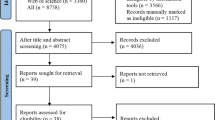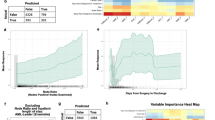Abstract
Background
Controversy still exists on the optimal surgical resection for potentially curable gastric cancer (GC). Use of radiologic evaluation and machine learning algorithms might predict extent of lymphadenectomy to limit unnecessary surgical treatment. We purposed to design a machine learning-based clinical decision-support model for predicting extent of lymphadenectomy (D1 vs. D2) in local advanced GC.
Methods
Clinicoradiologic features available from routine clinical assignments in 557 patients with GCs were retrospectively interpreted by an expert panel blinded to all histopathologic information. All patients underwent surgery using standard D2 resection. Decision models were developed with a logistic regression (LR), support vector machine (SVM) and auto-encoder (AE) algorithm in 371 training and tested in 186 test data, respectively. The primary end point was to measure diagnostic performance of decision model and a Japanese gastric cancer treatment guideline version 4th (JPN 4th) criteria for discriminate D1 (pT1 + pN0) versus D2 (≥ pT1 + ≥ pN1) lymphadenectomy.
Results
The decision model with AE analysis produced highest area under ROC curve (train: 0.965, 95% confidence interval (CI) 0.948–0.978; test: 0.946, 95% CI 0.925–0.978), followed by SVM (train: 0.925, 95% CI 0.902–0.944; test: 0.942, 95% CI 0.922–0.973) and LR (train: 0.886, 95% CI 0.858–0.910; test: 0.891, 95% CI 0.891–0.952). By this improvement, overtreatment was reduced from 21.7% (121/557) by treat-all pattern, to 15.1% (84/557) by JPN 4th criteria, and to 0.7–0.9% (4–5/557) by the new approach.
Conclusions
The decision model with machine learning analysis demonstrates high accuracy for identifying patients who are candidates for D1 versus D2 resection. Its approximate 14–20% improvements in overtreatment compared to treat-all pattern and JPN 4th criteria potentially increase the number of patients with local advanced GCs who can safely avoid unnecessary lymphadenectomy.





Similar content being viewed by others
References
Siegel RL, Miller KD, Jemal A (2018) Cancer statistics, 2018. CA: a cancer journal for clinicians; 68(1): 7–30.
Wu CW, Hsiung CA, Lo SS et al (2006) Nodal dissection for patients with gastric cancer: a randomised controlled trial. The Lancet Oncol 7(4): 309–315.
Sasako M, Sano T, Yamamoto S et al (2008) D2 lymphadenectomy alone or with para-aortic nodal dissection for gastric cancer. N. Engl. J. Med 359(5): 453–462.
Songun I, Putter H, Kranenbarg EM et al (2010) Surgical treatment of gastric cancer: 15-year follow-up results of the randomised nationwide Dutch D1D2 trial. The Lancet Oncol 11(5): 439–449.
Cuschieri A, Weeden S, Fielding J et al (1999) Patient survival after D1 and D2 resections for gastric cancer: long-term results of the MRC randomized surgical trial. Surgical Co-operative Group. Br. J. Cancer 79(9–10): 1522–1530.
Japanese Gastric Cancer A. Japanese gastric cancer treatment guidelines 2014 (ver. 4). Gastric cancer: official journal of the International Gastric Cancer Association and the Japanese Gastric Cancer Association 2017; 20(1): 1–19.
Ahn HS, Kim SH, Kodera Y, Yang HK (2013) Gastric cancer staging with radiologic imaging modalities and UICC staging system. Dig. Surg 30(2): 142–9.
Kim JW, Shin SS, Heo SH et al (2012) Diagnostic performance of 64-section CT using CT gastrography in preoperative T staging of gastric cancer according to 7th edition of AJCC cancer staging manual. Eur. Radiol 22(3): 654–662.
Lee SL, Ku YM, Jeon HM, Lee HH (2017) Impact of the Cross-Sectional Location of Multidetector Computed Tomography Scans on Prediction of Serosal Exposure in Patients with Advanced Gastric Cancer. Ann Surg Oncol 24(4): 1003–1009.
Hur J, Park MS, Lee JH et al (2006) Diagnostic accuracy of multidetector row computed tomography in T- and N staging of gastric cancer with histopathologic correlation. J Comput Assist Tomo 30(3): 372–377.
Kim SH, Kim JJ, Lee JS et al (2013) Preoperative N staging of gastric cancer by stomach protocol computed tomography. J Gastric Cancer 13(3): 149–156.
Stabile Ianora AA, Telegrafo M, Lucarelli NM et al(2017) Comparison between CT Net enhancement and PET/CT SUV for N staging of gastric cancer: A case series. Ann Med Surg 21: 1–6.
Kim HJ, Kim AY, Oh ST et al (2005) Gastric cancer staging at multi-detector row CT gastrography: comparison of transverse and volumetric CT scanning. Radiology 236(3): 879–885.
Maccioni F, Marcelli G, Al Ansari N et al (2010) Preoperative T and N staging of gastric cancer: magnetic resonance imaging (MRI) versus multi detector computed tomography (MDCT). Clin Ter 161(2): e57–62.
Huang CM, Xu M, Wang JB et al (2014) Is tumor size a predictor of preoperative N staging in T2-T4a stage advanced gastric cancer? Surg Oncol 23(1): 5–10.
Hwang SH, Kim HI, Song JS, Lee MH, Kwon SJ, Kim MG (2016) The Ratio-Based N Staging System Can More Accurately Reflect the Prognosis of T4 Gastric Cancer Patients with D2 Lymphadenectomy Compared with the 7th American Joint Committee on Cancer/Union for International Cancer Control Staging System. J Gastric Cancer 16(4): 207–214.
Dorfman RE, Alpern MB, Gross BH, Sandler MA (1991). Upper abdominal lymph nodes: criteria for normal size determined with CT. Radiology 180(2): 319–322.
Chen CY, Hsu JS, Wu DC et al (2007) Gastric cancer: preoperative local staging with 3D multi-detector row CT–correlation with surgical and histopathologic results. Radiology 242(2): 472–482.
Peng CW, Wang LW, Zeng WJ, Yang XJ, Li Y (2013) Evaluation of the staging systems for gastric cancer. J Surg Oncol 108(2): 93–105.
Washington K (2010) 7th edition of the AJCC cancer staging manual: stomach. Ann Surg Oncol 17(12): 3077–3079.
Kumano S, Okada M, Shimono T et al (2012) T-staging of gastric cancer of air-filling multidetector-row CT: comparison with hydro-multidetector-row CT. Eur J Radiol 81(11): 2953–2960.
Lee IJ, Lee JM, Kim SH et al (2009) Helical CT evaluation of the preoperative staging of gastric cancer in the remnant stomach. AJR Am J Roentgenol 192(4): 902–908.
Kumano S, Murakami T, Kim T et al (2005) T staging of gastric cancer: role of multi-detector row CT. Radiology 237(3): 961–966.
Fairweather M, Jajoo K, Sainani N, Bertagnolli MM, Wang J (2015) Accuracy of EUS and CT imaging in preoperative gastric cancer staging. J Surg Oncol 111(8): 1016–1020.
Hong ZL, Chen QY, Zheng CH et al (2017) A preoperative scoring system to predict the risk of No. 10 lymph node metastasis for advanced upper gastric cancer: a large case report based on a single-center study. Oncotarget 8(45): 80050–80060.
Xu S, Feng L, Chen Y et al (2017) Consistency mapping of 16 lymph node stations in gastric cancer by CT-based vessel-guided delineation of 255 patients. Oncotarget 8(25): 41465–41473.
Peng C, Liu J, Yang G, Li Y (2018) The tumor-stromal ratio as a strong prognosticator for advanced gastric cancer patients: proposal of a new TSNM staging system. J Gastroenterol 53(5):606–617
Choi YY, An JY, Katai H et al (2016) A Lymph Node Staging System for Gastric Cancer: A Hybrid Type Based on Topographic and Numeric Systems. PloS one 11(3): e0149555.
Chen J, Chen C, He Y, Wu K, Wu H, Cai S (2014) A new pN staging system based on both the number and anatomic location of metastatic lymph nodes in gastric cancer. J Gastrointest Surg 18(12): 2080–2088.
Aerts HJ, Velazquez ER, Leijenaar RT et al (2014) Decoding tumour phenotype by noninvasive imaging using a quantitative radiomics approach. Na Commun 5: 4006.
Kermany DS, Goldbaum M, Cai W et al (2018) Identifying Medical Diagnoses and Treatable Diseases by Image-Based Deep Learning. Cell 172(5): 1122–31 e9.
Huang YQ, Liang CH, He L et al (2016) Development and Validation of a Radiomics Nomogram for Preoperative Prediction of Lymph Node Metastasis in Colorectal Cancer. J Clin Oncol 34(18): 2157–2164.
Kim AY, Kim HJ, Ha HK (2005) Gastric cancer by multidetector row CT: preoperative staging. Abdom Imaging 30(4): 465–472.
Makino T, Fujiwara Y, Takiguchi S et al (2011) Preoperative T staging of gastric cancer by multi-detector row computed tomography. Surgery 149(5): 672–679.
Vickers AJ, Elkin EB (2006) Decision curve analysis: a novel method for evaluating prediction models. Med Decis Making 26(6): 565–574.
Zhang CD, Ning FL, Zeng XT, Dai DQ (2018) Lymphovascular invasion as a predictor for lymph node metastasis and a prognostic factor in gastric cancer patients under 70 years of age: A retrospective analysis. Int J Surg 53:214–220
Ozawa Y, Chiba N, Hikita K et al (2017) Long-Term Survival of a Gastric Neuroendocrine Carcinoma Patient with Extra-Regional Lymph Node Metastases. Gan To Kagaku Ryoho 44(4): 333–336.
Naffouje SA, Salti GI (2017) Extensive Lymph Node Dissection Improves Survival among American Patients with Gastric Adenocarcinoma Treated Surgically: Analysis of the National Cancer Database. J Gastric Cancer 17(4): 319–330.
Marin Cordova NE, Yan-Quiroz EF, Diaz Plasencia J, Churango Barreto K, Calvanapon Prado P, Salazar Abad S (2017) Prognostic significance of the ratio of lymph node metastatic in 5-year survival after curative gastrectomy for advanced gastric carcinoma. Rev Gastroenterol Peru 37(3): 217–224.
Lu J, Wang W, Zheng CH et al (2017) Influence of Total Lymph Node Count on Staging and Survival After Gastrectomy for Gastric Cancer: An Analysis From a Two-Institution Database in China. Ann Surg Oncol 24(2): 486–493.
Polkowski M, Palucki J, Wronska E, Szawlowski A, Nasierowska-Guttmejer A, Butruk E (2004) Endosonography versus helical computed tomography for locoregional staging of gastric cancer. Endoscopy 36(7): 617–623.
Botet JF, Lightdale CJ, Zauber AG et al (1991) Preoperative staging of gastric cancer: comparison of endoscopic US and dynamic CT. Radiology 181(2): 426–432.
Pereira MA, Ramos M, Dias AR et al (2018) Risk Factors for Lymph Node Metastasis in Western Early Gastric Cancer After Optimal Surgical Treatment. J Gastrointest Surg 22(1): 23–31.
Chen L, Wang YH, Cheng YQ et al (2017) Risk factors of lymph node metastasis in 1620 early gastric carcinoma radical resections in Jiangsu Province in China: A multicenter clinicopathological study. J Dig Dis 18(10): 556–565.
Miles KA (1999) Tumour angiogenesis and its relation to contrast enhancement on computed tomography: a review. Eur J Radiol 30(3): 198–205.
Fukuya T, Honda H, Hayashi T et al (1995) Lymph-node metastases: efficacy for detection with helical CT in patients with gastric cancer. Radiology 197(3): 705–711.
Funding
This study is supported by a Key Social Development Program for the Ministry of Science and Technology of Jiangsu Province (BE2017756, YDZ)
Author information
Authors and Affiliations
Corresponding authors
Ethics declarations
Conflict of interest
The authors have nothing to declare.
Ethical approval
The study was approved by the Institutional Review Board of the First Affiliated Hospital of Nanjing Medical University.
Informed consent
Written informed consent was waived by the Institutional Review Board.
Additional information
Publisher's Note
Springer Nature remains neutral with regard to jurisdictional claims in published maps and institutional affiliations.
Electronic supplementary material
Below is the link to the electronic supplementary material.
Rights and permissions
About this article
Cite this article
Liu, C., Qi, L., Feng, QX. et al. Performance of a machine learning-based decision model to help clinicians decide the extent of lymphadenectomy (D1 vs. D2) in gastric cancer before surgical resection. Abdom Radiol 44, 3019–3029 (2019). https://doi.org/10.1007/s00261-019-02098-w
Published:
Issue Date:
DOI: https://doi.org/10.1007/s00261-019-02098-w




